Click on images to enlarge
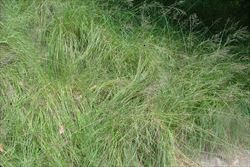
dense infestation (Photo: Sheldon Navie)
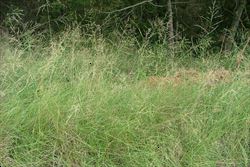
infestation (Photo: Sheldon Navie)
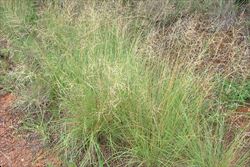
habit (Photo: Sheldon Navie)
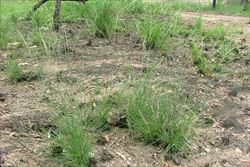
habit regenerating after fire (Photo: Sheldon Navie)
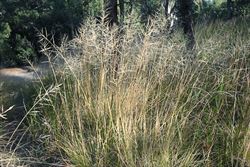
habit during dry season (Photo: Sheldon Navie)
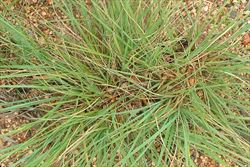
leaves (Photo: Sheldon Navie)
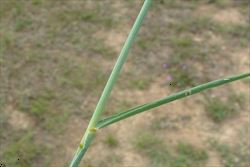
close-up of stem and base of leaf blade (Photo: Sheldon Navie)
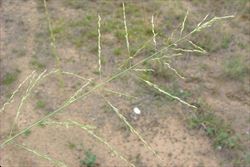
young seed-head (Photo: Sheldon Navie)
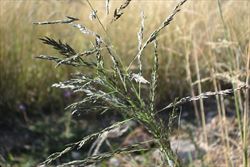
close-up of flower spikelets (Photo: Sheldon Navie)

mature seed-head (Photo: Sheldon Navie)
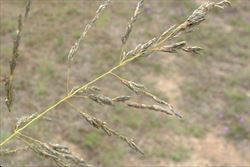
close-up of mature flower-spikelets (Photo: Sheldon Navie)
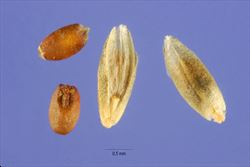
close-up of seeds (Photo: Steve Hurst at USDA PLANTS Database)
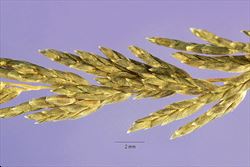
close-up of mature flower spikelets (Photo: Jose Hernandez at USDA PLANTS Database)
Scientific Name
Eragrostis curvula (Schrad.) Nees
Synonyms
Eragrostis chloromelas Steud.Eragrostis curvula (Schrad.) Nees var. valida StapfEragrostis jeffreysii HackelPoa curvula Schrad.
Family
Gramineae (South Australia)Poaceae (Queensland, New South Wales, the ACT, Victoria, Tasmania, Western Australia and the Northern Territory)
Common Names
African love grass, African lovegrass, Boer love grass, Boer lovegrass, weeping grass, weeping love grass, weeping lovegrass, wire grass
Origin
Native to southern Africa (i.e. Kenya, Tanzania, Mozambique, Zambia, Zimbabwe, Botswana, Lesotho, Namibia, South Africa and Swaziland).
Cultivation
African lovegrass (Eragrostis curvula) has been deliberately cultivated for erosion control and as a sown pasture on lighter soils in the winter rainfall areas of southern Australia. In recent times, the more leafy and less weedy cultivar known as 'Consol' has generally been planted, rather than the typical weedy form of the species.
Naturalised Distribution
A very widely naturalised species that is most abundant in the southern and eastern parts of the country. It is common in eastern New South Wales, the ACT, south-eastern Queensland and south-western Western Australia and has a more scattered distribution in Victoria and the southern parts of South Australia. Also present in other parts of New South Wales, Queensland and Western Australia, naturalised in the southern parts of the Northern Territory, and sparingly naturalised in Tasmania.
Naturalised overseas in the UK, northern Africa, the Canary Islands, Asia, New Zealand, USA and tropical America.
Habitat
A common weed of semi-arid, sub-tropical and temperate regions that is occasionally also found in tropical and arid environments. It infests roadsides, railway lines, waste areas, disturbed sites, footpaths, pastures, grasslands, open woodlands, waterways and coastal sites.
Habit
A relatively large, densely tufted, and mostly upright (i.e. erect) long-lived (i.e. perennial) grass growing 30-120 cm tall.
Distinguishing Features
- a relatively large and tufted long-lived grass with stems growing 30-120 cm tall.
- its stems and leaves are mostly upright, but are sometimes arched or slightly weeping in nature.
- its leaf blades are linear and often have in-rolled margins.
- its seed-head is a much-branched open panicle with a large number of greyish-green or purplish coloured flower spikelets.
- these flower spikelets are flattened, elongated in shape, and contain 4-13 tiny flowers.
Stems and Leaves
Its hairless stems are usually slender and upright (i.e. erect), although they may sometimes be slightly drooping or weeping in nature.
The leaves consist of a leaf sheath, which partially encloses the stem, and a spreading leaf blade. They are densely tufted near the base of the plant and are often arched towards the ground, giving the plant a weeping appearance. The long and narrow (i.e. linear) leaf blades (5-35 cm long and 0.5-5 mm wide) have entire margins and gradually narrow to a pointed tip (i.e. acute or acuminate apex). Where the leaf sheath meets the leaf blade there is a line of tiny hairs (i.e. a ciliated ligule) 0.3-1 mm long. The leaf blades are roughly textured (i.e. scabrous) and often have their margins rolled inwards (i.e. they are involute).
Flowers and Fruit
The seed-head (i.e. inflorescence) is a large open panicle (6-30 cm long and 4-20 cm wide) that is initially rather compact, but usually becomes loose and spreading as it matures. These panicles have many branches, several of which may spread from the same point at the base of the cluster (i.e. the lowest branches are sometimes whorled). The numerous flower spikelets (4-10 mm long and 1-1.5 mm wide) are initially grey, greyish-green or purplish in colour, but become paler and turn straw-coloured as they mature. These flower spikelets are somewhat flattened (i.e. laterally compressed), with a pair of bracts (i.e. glumes) at the base and several (4-13) tiny flowers (i.e. florets). Flowering occurs throughout much of the year, but is most abundant from early summer through until early winter.
When the flower spikelets are mature they break apart and release the seeds. The seeds are tiny (0.3-0.7 mm long), oval (i.e. ellipsoid) or almost rounded (i.e. sub-globular) in shape, and can be whitish, yellow, orange, brownish or black in colour. Mature seeds are usually present during late summer and early autumn (i.e. from January to March).
Reproduction and Dispersal
This species reproduces by seed. Seeds can be dispersed in mud, soil and contaminated agricultural produce. They may also be spread by wind, water, animals and vehicles. For example, slashing infested roadsides is a common method of dispersal, as the seed is easily transported to new areas on the machinery. Animals spread the seeds on their fur and hooves, and recent studies have also shown that cattle feeding on African lovegrass (Eragrostis curvula) can excrete viable seed up to 10 days after consuming them.
Environmental Impact
African lovegrass (Eragrostis curvula) has already invaded large parts of Australia and is a major environmental weed in this country. It is currently regarded as a significant environmental weed Victoria, the ACT, New South Wales, Queensland and Western Australia, and is also seen as an emerging environmental weed or "sleeper weed" in Tasmania and South Australia. During a recent survey it was listed as a priority environmental weed in ten Natural Resource Management regions, placing it as one of the most widespread species of concern.
African lovegrass (Eragrostis curvula) is an early coloniser of disturbed sites, and is typically found in sandy or gravely soils, on roadsides, along watercourses and in pastures. It can survive long dry periods, and recovers quickly after disturbance events (e.g. fires). African lovegrass (Eragrostis curvula) grows rapidly and can form dense swards which crowd out more desirable species in pastures and natural vegetation. As well as replacing native species, it can create additional environmental impacts, such as preventing their regeneration and increasing the intensities of bushfires through higher fuel loads.
This invasive species is common along roadsides and in disturbed sites in south-western Western Australia and is invading adjacent bushland from Carnarvon to the Nullarbor Plain. It is also an important weed of wetland areas in the southern parts of Western Australia and threatens the survival of some native plant species. For example, the endangered narrow-petalled featherflower (Verticordia plumosa var. pleiobotrya) is limited to a few natural populations in south-western Western Australia. Weed invasion is a major threat to all of these populations, and African lovegrass (Eragrostis curvula) is one of the most prominent of these weed species. It directly affects this threatened species through suppression of early plant growth, and also increases the fire hazard due to the high fuel loads it produces.
It also grows in similar habitats in New South Wales (i.e. on roadsides, along watercourses and in pastures) and is a particularly serious weed of remnant native grassy vegetation in farming areas in this state. African lovegrass (Eragrostis curvula) can transform these threatened communities by modifying their composition, structure and processes. For example, it is seen as a threat to Bega dry grass forests in the South East Corner bioregion of New South Wales and is a similar threat to natural temperate grasslands throughout the Southern Tablelands of New South Wales and the Australian Capital Territory. African lovegrass (Eragrostis curvula) is also one of the group of exotic perennial grasses that have been listed as being a "key threatening process" in New South Wales. It is also a threat to individual species in this state. For example, it is one of the weeds directly impacting on locally threatened populations of the pine donkey orchid (Diuris tricolor) in the Muswellbrook area.
In Victoria, African lovegrass (Eragrostis curvula) is common from the East Gippsland region to the Mallee region, where it has invaded heathlands, woodlands and grasslands. In south-eastern Queensland it is becoming increasingly common, and it was recently ranked among the top 50 most invasive plant species in this region. It is often associated with sandy and saline soils in South Australia, where it is regarded as an aggressive invader that is continuing to spread, and it is particularly common in coastal habitats in the Gulf St. Vincent region near Adelaide.
Other Impacts
African lovegrass (Eragrostis curvula) readily spreads from roadsides and disturbed sites into neighbouring degraded pastures. It is extremely competitive with other pasture species and quickly overtakes overgrazed or poor quality pastures, particularly in sandy soils. When mature it is not readily eaten by livestock, and this increases the competition on more preferable pasture species. It also has a low nutritional value, resulting in stock performing poorly in infested pastures, thereby significantly decreasing pasture productivity.
There is also concern that African lovegrass (Eragrostis curvula) could invade lucerne and summer cropping areas in Queensland, where it may contaminate these commodities. Because it is highly flammable, particularly during the dry season, dense infestations also create an increased fire hazard for people and property.
Legislation
This species is declared under legislation in the following states and territories:
- ACT: C3 - a pest plant that must be contained.
- New South Wales: Class 4 - a locally controlled weed. The growth and spread of this species must be controlled according to the measures specified in a management plan published by the local control authority and the plant may not be sold, propagated or knowingly distributed (in a large number of local authority areas). See the New South Wales Department of Primary Industries Noxious Weeds List at http://www.dpi.nsw.gov.au for more detailed information on which local areas are covered in these declarations.
- South Australia: 2@ - this species is is a statewide pest plant. It is declared, and its control is required, throughout the whole of the state. This declaration excludes the cultivar known as 'Consol' (i.e. Eragrostis curvula 'Consol').
- Tasmania: D - the importation or sale of this species is prohibited and measures to reduce its population in an area, eradicate it from an area, or restrict it to a particular area may be required.
- Victoria: P5 - prohibited and must be eradicated or controlled (in the Mallee, North Central, North East, West Gippsland and East Gippsland regions), and C2 - all reasonable steps must be taken to control the weed and prevent its spread (in the Port Phillip West and Goulburn regions).
- Western Australia: Unassessed - this species is declared in other states or territories and is prohibited until assessed via a weed risk assessment (throughout the entire state).
Management
For information on the management of this species see the following resources:
- the Victorian Department of Primary Industries Landcare Note on this species, which is available online at http://www.dpi.vic.gov.au.
- the Biosecurity Queensland Fact Sheet on this species, which is available online at http://www.dpi.qld.gov.au.
Similar Species
African lovegrass (Eragrostis curvula) is very similar to many introduced and native lovegrasses (Eragrostis spp.) and an expert may be required to confidently distinguish between them. Some of the most common weedy species include stinkgrass (Eragrostis cilianensis), Mexican lovegrass (Eragrostis mexicana) and elastic grass (Eragrostis tenuifolia). These species can be distinguished by the following differences:
- African lovegrass (Eragrostis curvula) is a long-lived (i.e. perennial) plant (growing up to 120 cm tall) with mostly upright seed-heads that do not droop or 'weep' when mature. Its flower spikelets are greyish-green (occasionally purplish) in colour, relatively small (4-10 mm long and 1-1.5 mm wide), and have several (4-13) florets.
- stinkgrass (Eragrostis cilianensis) is a short-lived (i.e. annual) plant (less than 60 cm tall) with upright seed-heads that do not droop or 'weep' very much when mature. Its flower spikelets are greyish-green in colour, relatively large (3-30 mm long and 2-4 mm wide), and have numerous (5-60) florets.
- Mexican lovegrass (Eragrostis mexicana) is a short-lived (i.e. annual) plant (usually less than 60 cm tall) with upright seed-heads that do not droop or 'weep' when mature. Its flower spikelets are greyish-green or purplish in colour, relatively small (3.5-9.5 mm long and about 2 mm wide), and have several (5-16) florets.
- elastic grass (Eragrostis tenuifolia) is a long-lived (i.e. perennial) plant (up to 60 cm tall) with upright seed-heads that do not droop or 'weep' when mature. Its flower spikelets are greyish-green in colour, relatively small (4-16 mm long and 1-3 mm wide), and have several (4-16) florets.
Note: For a more in-depth key to all of the grasses present in Australia, see the AusGrass: Grasses of Australia CD-ROM or Flora of Australia, Volumes 43 and 44.

